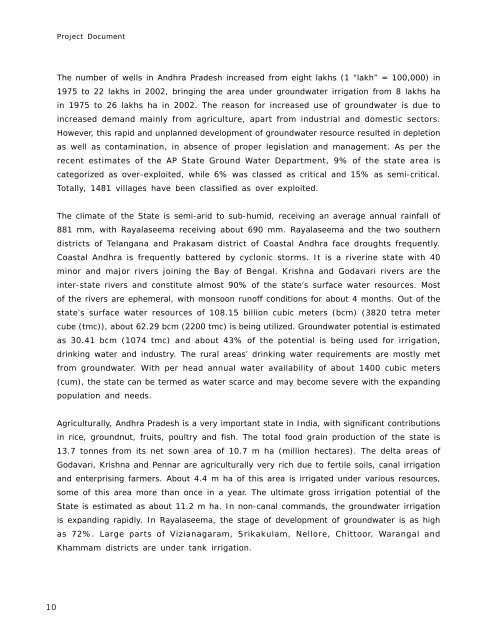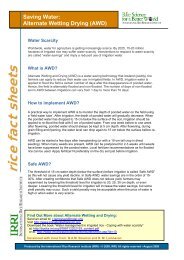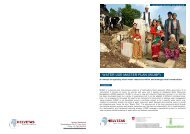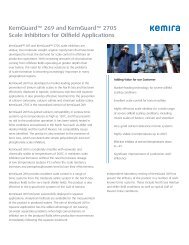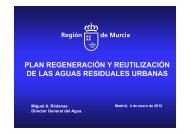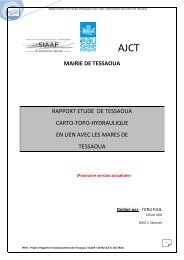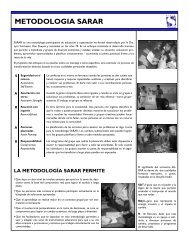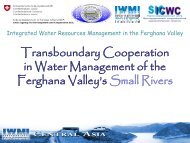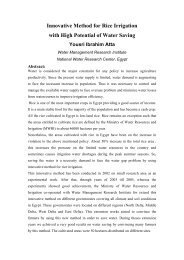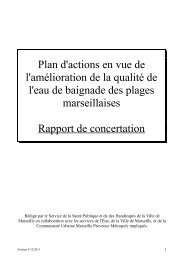FAO Project Document book - Solutions for Water platform - World ...
FAO Project Document book - Solutions for Water platform - World ...
FAO Project Document book - Solutions for Water platform - World ...
You also want an ePaper? Increase the reach of your titles
YUMPU automatically turns print PDFs into web optimized ePapers that Google loves.
<strong>Project</strong> <strong>Document</strong><br />
The number of wells in Andhra Pradesh increased from eight lakhs (1 “lakh” = 100,000) in<br />
1975 to 22 lakhs in 2002, bringing the area under groundwater irrigation from 8 lakhs ha<br />
in 1975 to 26 lakhs ha in 2002. The reason <strong>for</strong> increased use of groundwater is due to<br />
increased demand mainly from agriculture, apart from industrial and domestic sectors.<br />
However, this rapid and unplanned development of groundwater resource resulted in depletion<br />
as well as contamination, in absence of proper legislation and management. As per the<br />
recent estimates of the AP State Ground <strong>Water</strong> Department, 9% of the state area is<br />
categorized as over-exploited, while 6% was classed as critical and 15% as semi-critical.<br />
Totally, 1481 villages have been classified as over exploited.<br />
The climate of the State is semi-arid to sub-humid, receiving an average annual rainfall of<br />
881 mm, with Rayalaseema receiving about 690 mm. Rayalaseema and the two southern<br />
districts of Telangana and Prakasam district of Coastal Andhra face droughts frequently.<br />
Coastal Andhra is frequently battered by cyclonic storms. It is a riverine state with 40<br />
minor and major rivers joining the Bay of Bengal. Krishna and Godavari rivers are the<br />
inter-state rivers and constitute almost 90% of the state’s surface water resources. Most<br />
of the rivers are ephemeral, with monsoon runoff conditions <strong>for</strong> about 4 months. Out of the<br />
state’s surface water resources of 108.15 billion cubic meters (bcm) (3820 tetra meter<br />
cube (tmc)), about 62.29 bcm (2200 tmc) is being utilized. Groundwater potential is estimated<br />
as 30.41 bcm (1074 tmc) and about 43% of the potential is being used <strong>for</strong> irrigation,<br />
drinking water and industry. The rural areas’ drinking water requirements are mostly met<br />
from groundwater. With per head annual water availability of about 1400 cubic meters<br />
(cum), the state can be termed as water scarce and may become severe with the expanding<br />
population and needs.<br />
Agriculturally, Andhra Pradesh is a very important state in India, with significant contributions<br />
in rice, groundnut, fruits, poultry and fish. The total food grain production of the state is<br />
13.7 tonnes from its net sown area of 10.7 m ha (million hectares). The delta areas of<br />
Godavari, Krishna and Pennar are agriculturally very rich due to fertile soils, canal irrigation<br />
and enterprising farmers. About 4.4 m ha of this area is irrigated under various resources,<br />
some of this area more than once in a year. The ultimate gross irrigation potential of the<br />
State is estimated as about 11.2 m ha. In non-canal commands, the groundwater irrigation<br />
is expanding rapidly. In Rayalaseema, the stage of development of groundwater is as high<br />
as 72%. Large parts of Vizianagaram, Srikakulam, Nellore, Chittoor, Warangal and<br />
Khammam districts are under tank irrigation.<br />
10


